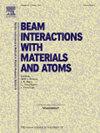1 MeV等效中子辐照对GaInP/GaAs/Ge太阳能电池电学和光谱特性的影响
IF 1.4
3区 物理与天体物理
Q3 INSTRUMENTS & INSTRUMENTATION
Nuclear Instruments & Methods in Physics Research Section B-beam Interactions With Materials and Atoms
Pub Date : 2025-05-31
DOI:10.1016/j.nimb.2025.165760
引用次数: 0
摘要
二十年来,GaInP/GaAs/Ge三结太阳能电池由于其高转换效率而被用作主要的卫星电源。然而,大气中子和核动力航天器(如火星探测)产生的中子会引起位移损伤,降低电池性能。现有的研究缺乏中子辐射损伤的微观机制解释。本文采用实验与模拟相结合的方法对中子辐照损伤行为及其机理进行了研究。研究发现,随着中子通量的增加,电学特性有较大的退化,位移损伤主要发生在砷化镓中间电池。利用Geant4和TCAD联合模拟得到的中子辐照缺陷模型,载流子浓度分布在GaAs中间电池中表现出更严重的降解。此外,根据复合率分布和能带结构分布,发现在高中子通量下缺陷机制可能发生变化。本文章由计算机程序翻译,如有差异,请以英文原文为准。
Influence of 1 MeV equivalent neutron irradiation on electrical and spectral properties of GaInP/GaAs/Ge solar cells
GaInP/GaAs/Ge triple-junction solar cells have served as primary satellite power sources for two decades owing to their high conversion efficiency. However, atmospheric neutrons and those generated by nuclear-powered spacecraft (e.g., in Mars exploration) induce displacement damage, degrading cell performance. Existing studies lack microscopic-scale mechanistic interpretations of neutron radiation damage. Here, we investigated the neutron irradiation damage behavior and the underlying mechanism through the combination of experiment and simulation. It is found that there is a larger degradation of electrical characteristics with the increase of neutron fluence and the displacement damage mainly occurs in GaAs middle cell. Utilizing the neutron irradiation defect model obtained by the joint Geant4 and TCAD simulation, the carrier concentration distribution shows a more severe degradation in GaAs middle cell. Moreover, according to the recombination rate distribution and energy band structure distribution, it is found that the defect mechanism may change under high neutron fluence.
求助全文
通过发布文献求助,成功后即可免费获取论文全文。
去求助
来源期刊
CiteScore
2.80
自引率
7.70%
发文量
231
审稿时长
1.9 months
期刊介绍:
Section B of Nuclear Instruments and Methods in Physics Research covers all aspects of the interaction of energetic beams with atoms, molecules and aggregate forms of matter. This includes ion beam analysis and ion beam modification of materials as well as basic data of importance for these studies. Topics of general interest include: atomic collisions in solids, particle channelling, all aspects of collision cascades, the modification of materials by energetic beams, ion implantation, irradiation - induced changes in materials, the physics and chemistry of beam interactions and the analysis of materials by all forms of energetic radiation. Modification by ion, laser and electron beams for the study of electronic materials, metals, ceramics, insulators, polymers and other important and new materials systems are included. Related studies, such as the application of ion beam analysis to biological, archaeological and geological samples as well as applications to solve problems in planetary science are also welcome. Energetic beams of interest include atomic and molecular ions, neutrons, positrons and muons, plasmas directed at surfaces, electron and photon beams, including laser treated surfaces and studies of solids by photon radiation from rotating anodes, synchrotrons, etc. In addition, the interaction between various forms of radiation and radiation-induced deposition processes are relevant.

 求助内容:
求助内容: 应助结果提醒方式:
应助结果提醒方式:


